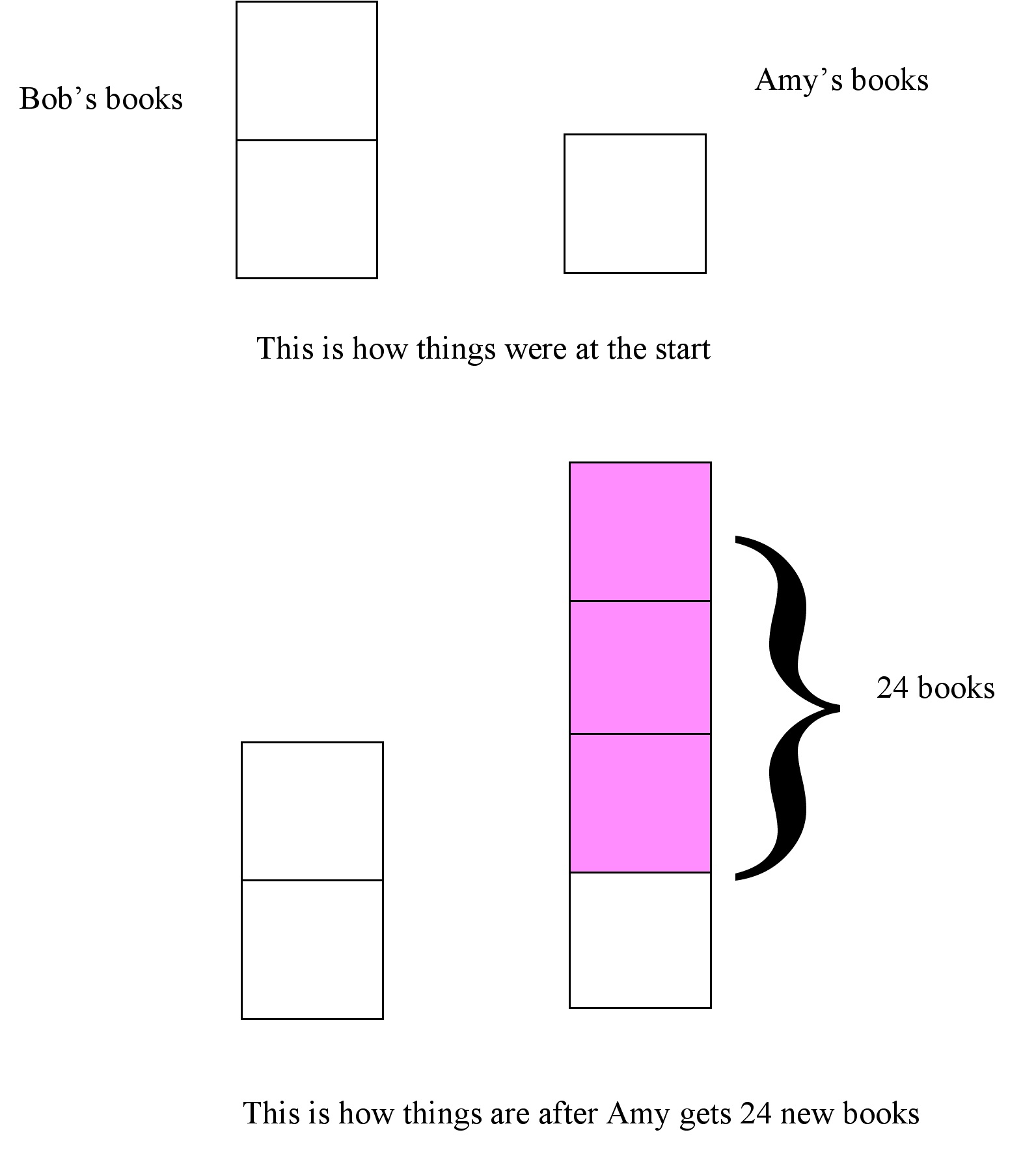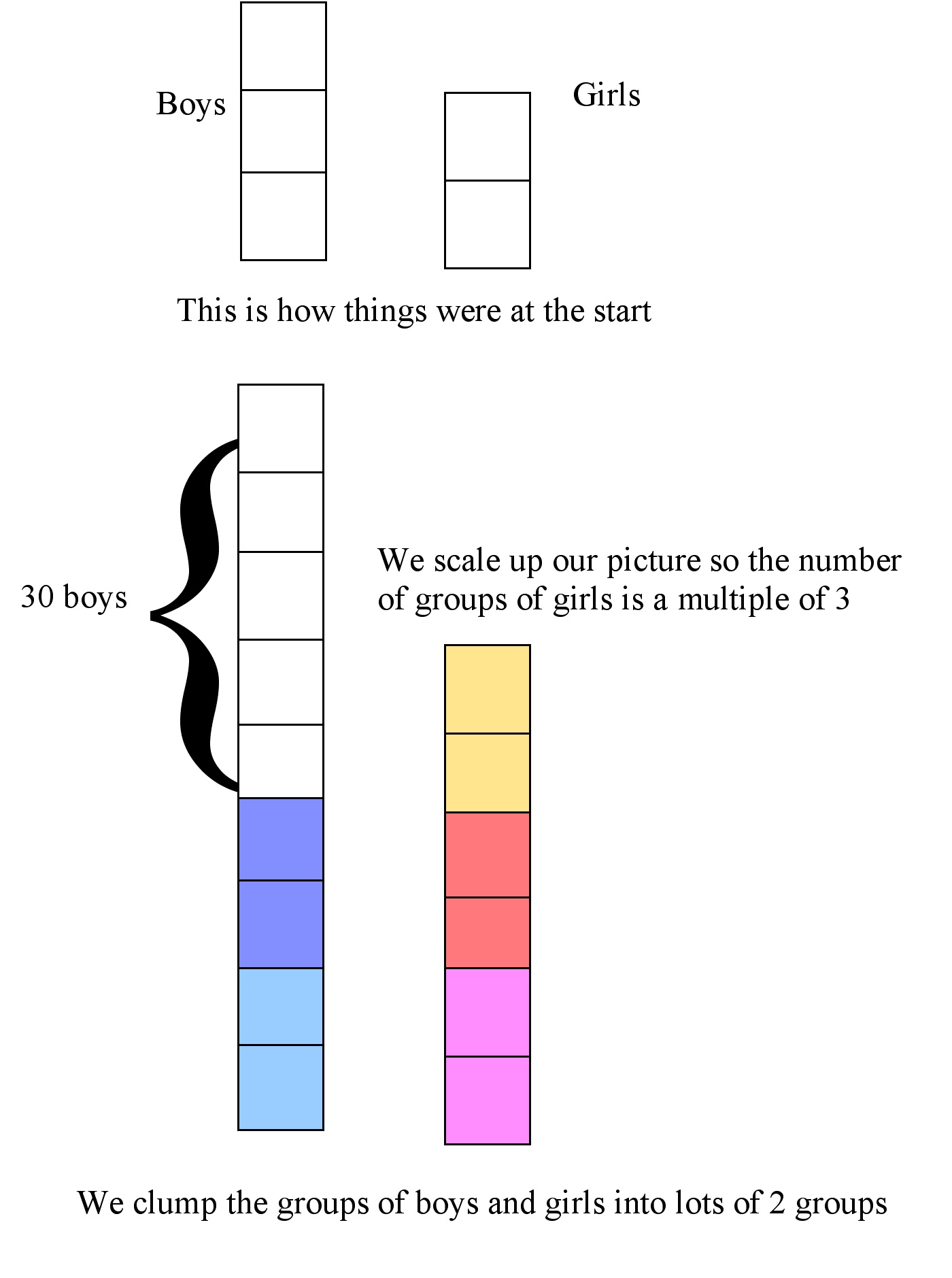Dealing with ratios diagramatically
Posted by: Gary Ernest Davis on: September 14, 2010
In an earlier post, I wrote that my colleague Sigal Gottlieb was annoyed by her own approach at automatically solving the following problem – which she had asked of her elder son – via algebra, rather than thinking through the problem in a more direct way:
In a large group of children there are 3 boys for every 2 girls. 30 boys leave the group and then in the smaller group that’s left there are 2 boys for every 3 girls. How many boys and girls were there in the original group?
To give the same flavor of the problem but make it a little easier for her younger son, she asked him:
Two children Amy and Bob, each have collections of books. Bob has twice as many books as does Amy. Amy’s mother buys her 24 new books and then Amy has twice as many books as does Bob. How many books did Amy and Bob have to begin?
The second problem
Let’s look at the second problem diagramatically:
 In this diagram we imagine Bob and Amy’s books to be evenly distributed in boxes: each box holds the same number of books.
In this diagram we imagine Bob and Amy’s books to be evenly distributed in boxes: each box holds the same number of books.
Bob has two boxes of books to Amy’s one box.
Amy then gets 24 more books.
Bob’s books stay the same so Amy has some more boxes.
In order to have a ratio of 2 to 1 Amy gets 3 extra boxes.
So 3 boxes, each with the same number of books, holds 24 books. Therefore 1 box holds 8 books.
So originally Bob, with 2 boxes, had 16 books and Amy, with 1 box, had 8 books.
The first problem
The first problem can be approached diagramatically in much the same way, but a little adjustment is in order because of the slightly more awkward ratio of 3:2
 In this diagram we begin with 5 equal size groups : 3 groups of boys and 2 groups of girls.
In this diagram we begin with 5 equal size groups : 3 groups of boys and 2 groups of girls.
We want to end up with a ratio the other way around, so one sensible thing to do is to scale up the picture by scaling the numbers of boys and girls by a factor of 3.
Then there are 9 groups of boys and 6 groups of girls – still a ratio of 3:2 for boys to girls.
Now let’s clump the groups into lots of 2, as shown by the coloring.
The girls now consist of 3 lots, each lot being 2 groups.
So the boys, after 30 leave, will have to be 2 lots, again each lot being 2 groups: 4 groups in all.
So, 9-4=5 groups of boys departed, and these 5 equal groups totaled 30 boys.
Therefore, 1 group has 6 students.
So originally there were 54 boys (9 groups of 6) and 36 girls (6 groups of 6).
Algebra
Of course algebra is pretty sweet too, just being arithmetic on names.
So, in the first problem, let b be the number of boys at the start, and g the number of girls.
Because there are 3 boys for every 2 girls we know that 2b=3g (think about it for a minute: it’s not the other way around, because “b” doesn’t stand for “boys” – it stands for “number of boys”, and “g” stands for “number of girls”, not “girls”).
After b has decreased by 30 we have b-30 boys and a ratio of 3 girls for every 2 boys.
So, 2g=3(b-30) (again think about it for a minute: it’s still not the other way around).
Let’s do some arithmetic on these names:
2g=3b-90 so 6g=9b-270.
Also, from 2b=3g we see that 4b=6g.
Combining these we see that 9b-270=4b.
Therefore, 5b=270 so b=54.
Then 3g=2b=108 so g=36. Ta-dah!
Notice I carefully avoided using fractional quantities.
Does it feel to you, as it does to me, that the diagrammatic solution and the algebraic solution seem to utilize different parts of our brains?
4 Responses to "Dealing with ratios diagramatically"
Sure. I think both are very valid ways to solve the problems for different learners. The diagrams are used in Singapore math as a way to start esp. for younger students.
Possibly the best paper that I have read ever?!

September 14, 2010 at 7:10 am
I just happened by (I don’t remember how; too many clicks).
I’d say, yes, the two approaches are quite different. The diagrams seem to me to appeal more to the visual parts of the brain (to oversimplify, the right side), while the algebraic approach is on the left.
There’s a conceptual difference as well, as I see it (keeping in mind that my college majors were English and sociology): it’s a big, though crucial, step to “transform” the boxes in the diagram.
From a very pedestrian view, you turned “unitary” boxes (1 box = 1 thing) into, um, “multiplexed” boxes (1 box = 1 set of maybe-more-than-one-thing-and-then-again-maybe-just-one).
So when you say “the sensible thing to do,” you’re doing so from the viewpoint of someone who already knows the secret. Learning, to me, is partly a result of trying to discern that secret.
Not that I’m objecting to that–I’m just seeing it as the turning point. A new learner has the potential for an aha moment if she can struggle with this for a while and come up with the unit-to-multiple transformation on her own.
Barring that, then a set of additional (not identical) problems provides opportunity to figure out whether the transformation applies, and how.
After doing enough of those, then the algebraic formulation is just a shorthand expression.
September 14, 2010 at 7:29 am
“So when you say “the sensible thing to do,†you’re doing so from the viewpoint of someone who already knows the secret.”
No, I did not “know the secret”. I wrote as I thought, and what I thought was that if I am going to have a final ratio of 3:2 for girls to boys, and now only have two groups of girls I am either (a) going to have to divide the groups into 3, or (b) expand by 3. I chose not to work with fractions.
That is what was going on in my mind. No “secret”.